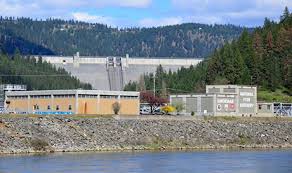The Department of the Interior today transferred fish production at Dworshak National Fish Hatchery to the Nez Perce Tribe, which the agency says is “an important move underscoring the Biden Administration’s commitment to empowering Indigenous communities and supporting Tribal trust responsibility.”
Secretary of the Interior Deb Haaland joined leadership from the Nez Perce Tribe, U.S. Fish and Wildlife Service and U.S. Army Corps of Engineers to tour the hatchery and commemorate the transfer. The fish produced at the hatchery serve help to meet the United States’ trust responsibility for protecting the resources reserved in the treaties between the Nez Perce Tribe and the United States.
“The transfer of fish production at the Dworshak National Fish Hatchery to the Nez Perce Tribe is a triumph that is nearly 20 years in the making, and a testament to what can happen when we work collaboratively,” said Haaland. “There is much to be gained when we respect and integrate Indigenous knowledge into our conservation initiatives. Today’s event commemorates Native people’s resilience, conservation efforts guided by Indigenous knowledge, and the Biden-Harris administration’s commitment to honor our trust responsibility and treaty obligations to Tribes.”
The Dworshak hatchery, located in the heart of the Nez Perce Reservation in Orofino, Idaho, has been jointly managed by the U.S. Fish and Wildlife Service and Nez Perce Tribe since 2005. The Service will continue its partnership with the Nez Perce Tribe by continuing to provide support to the hatchery through the Idaho Fish and Wildlife Conservation Office and Pacific Region Fish Health Program.
“The U.S. Fish and Wildlife Service’s wildlife management and conservation efforts are strengthened when we incorporate Indigenous knowledge and rely on the best available science,” said U.S. Fish and Wildlife Service Director Martha Williams. “I am proud of the work the Service has done to manage the fish production at this hatchery jointly with the Tribe – and I look forward to its continued success as we work to ensure that the fish hatchery and surrounding community continue to thrive together.”
The hatchery is located at the confluence of the North Fork and mainstem Clearwater River, 3 miles west of Orofino. The hatchery was constructed by the Corps in the late 1960’s to mitigate for the loss of steelhead in the North Fork of the Clearwater River and its tributaries as a result of the construction of Dworshak Dam. The Corps will continue to own the facility.
The hatchery has been co-managed by USFWS and the Nez Perce as a result of the Snake River Basin Adjudication settlement agreement. The Service and Tribe have maintained existing production goals for steelhead trout, Chinook salmon, and coho salmon and continue working together to enhance fishery resources of the Clearwater River Basin.
The hatchery produces 2.1 million steelhead, 2.55 million spring Chinook, and 500,000 coho salmon annually. These are all anadromous fish, meaning they make a 550-mile journey down the Snake and Columbia rivers as juveniles to the Pacific Ocean, then return as adults to spawn.
Steelhead and salmon have and continue to play a key role in the cultural past of the Native communities that once lived in or near the Clearwater River basin. The fish produced provide harvest opportunities for the shared Tribal and non-Tribal fisheries in the Clearwater, Snake and Columbia Rivers in Idaho, Washington and Oregon.
The Nez Perce people, also known as the Nimiipuu, lived and thrived in this region since time immemorial. The town of Ahsahka, next to the Dworshak hatchery, was once the site of the largest inland fishing village for Native Americans throughout the Pacific Northwest. Each season, Tribes would gather on this site and harvest from the abundant North Fork runs of Chinook and steelhead.
The hatchery produces large B-steelhead trout to mitigate for habitat lost in the North Fork Clearwater River due to the construction of Dworshak Dam, and produces spring Chinook salmon to mitigate for lost habitat due to construction of the four federal lower Snake River dams. The Nez Perce Tribe is also rebuilding coho salmon runs in the Clearwater River Basin through the Coho Restoration Program at the hatchery.
In the winter, Chinook and coho eggs hatch and develop in the darkness of incubation trays. Hatchery employees use the winter months to prepare the nursery for the busy spring. Steelhead trapping continues and adults are spawned.
In the spring, Chinook and steelhead smolts are released. New Chinook and coho fry are ponded into raceways. New steelhead juveniles move into the nursery from incubators and then to outside Burrows ponds. Steelhead spawning continues.
In the summer, adult Chinook trapping is followed by spawning. Juvenile fish continue growing outside. Adipose fin clipping and coded-wire tagging occurs.
In the fall, coho are trapped and spawned. Steelhead trapping begins as well. Spring Chinook eggs are kept on chilled water to ensure they develop in tune with their natural cycle.
The famous Clearwater “B” strain of steelhead trout return to the hatchery from the Pacific Ocean, more than 500 miles away, from October until May, and are spawned from January through April.
Chinook salmon return from May to August, and are spawned from late August to early September.
Adult coho salmon return from October thru late November, with spawning occurring during that time.

